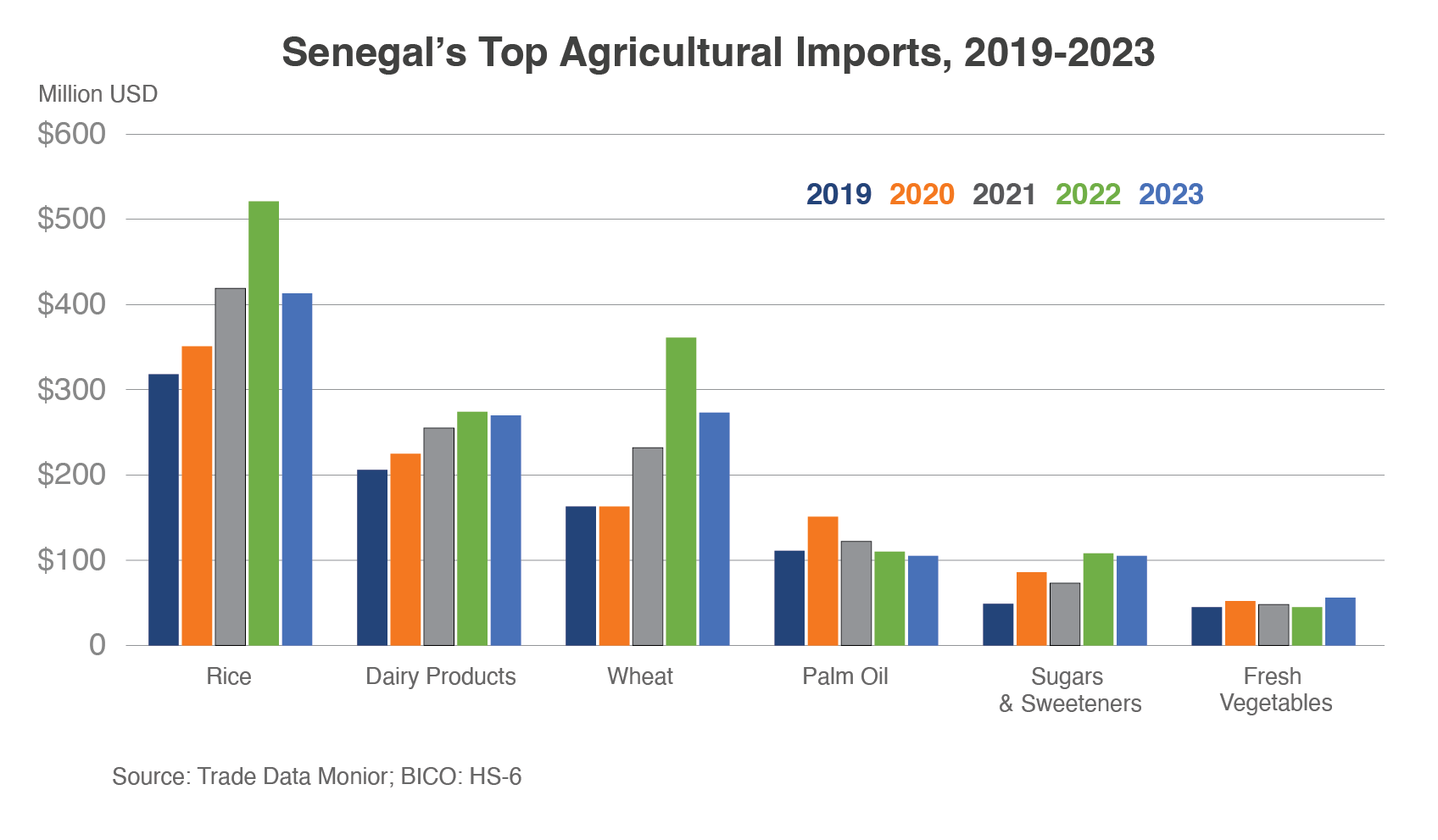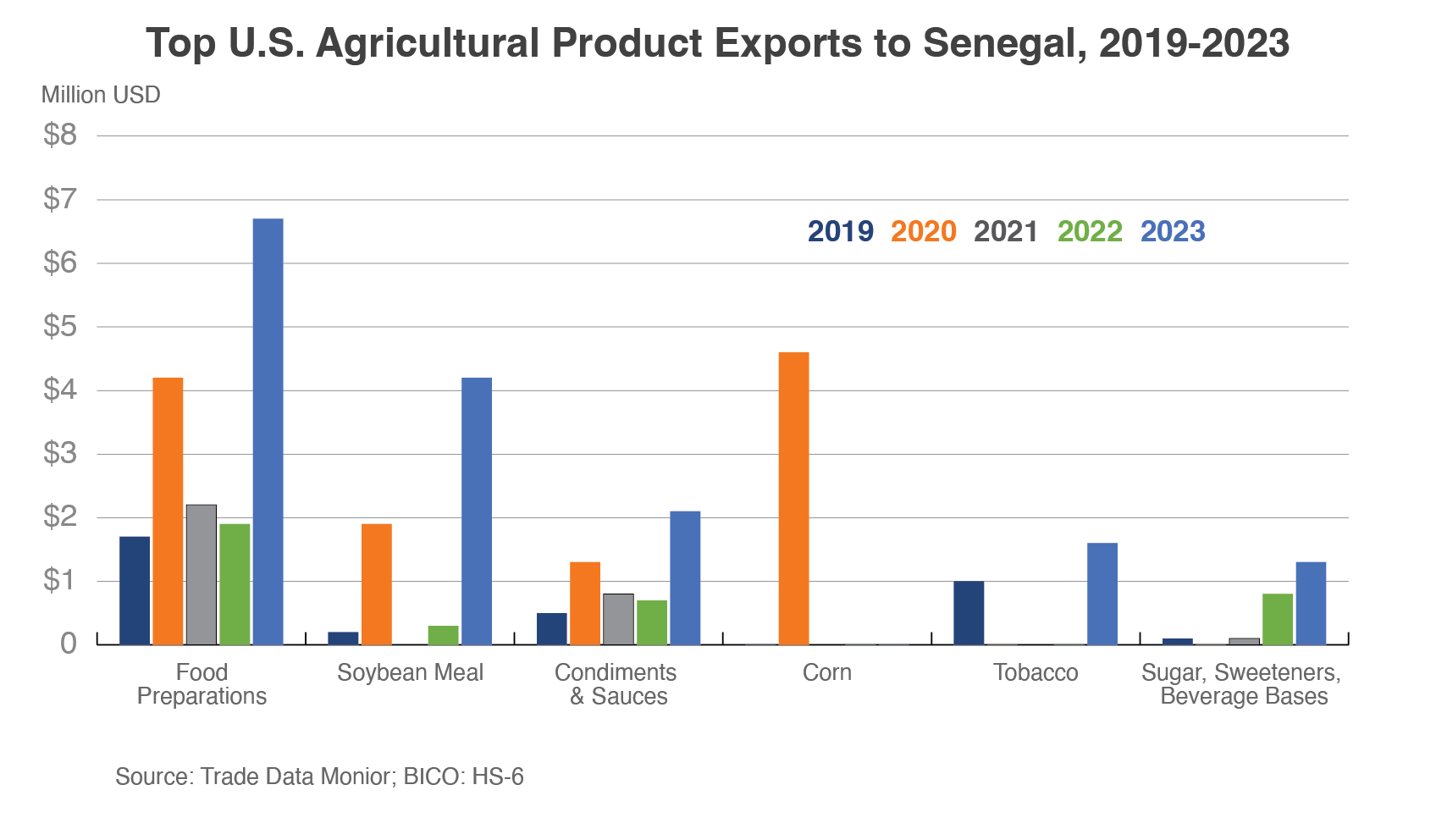Growth Potential for U.S. Agricultural Products in Senegal
Contact:
Link to report:
Executive Summary
Senegal imported over $1.8 billion in agricultural products annually over the past five years. Senegal’s top agricultural imports include rice, dairy products, wheat, palm oil, corn, and sugars and sweeteners. While the United States holds a 5-year average of less than 1 percent market share ($20.7 million in 2023 exports), Senegal has a growing food manufacturing industry that seeks cost-competitive ingredients and is expanding its exports to neighboring countries. Consumer demand for new and diverse consumer products is growing and U.S. branded products are sought after but remain scarce in the Senegalese market. Senegal is a stable country in the West African region and its location offers access to neighboring markets such as The Gambia, Guinea, Mali, and Mauritania. Currently, Senegal still faces high prices lingering from post-COVID global inflation, but the economic outlook is promising with new domestic oil and gas production on the horizon.
Macroeconomic Indicators
The World Bank reports Senegal’s gross domestic product per capita (Purchasing Power Parity constant 2021 international $) at $4,356, a 1-percent increase from 2022. The International Monetary Fund (IMF) reported inflation at 5.9 percent in 2023, much lower than previous forecasts, and it has continued to decline, currently sitting at 3.9 percent in 2024. Senegal continues to be one of the strongest economies in sub-Saharan Africa. Investment expansions are fueled by Senegal’s new oil and gas production. Of a population of 17.8 million in 2023, 56 percent was between the ages of 15 and 64 according to the World Bank, and the share of rural population, currently at 50 percent, is steadily decreasing. With higher urbanization rates and a growing middle and upper class, supermarket chain development has expanded, creating more export opportunities for diverse consumer-oriented products.
Senegal’s New Oil and Gas Production
Senegal’s new oil and gas industry could lead to significant economic growth and subsequent increases in imports associated with middle- to upper-class consumption, including but not limited to high-quality processed food products, commodities for food and beverage manufacturing, and beef and beef products. In June 2024, Senegal began producing oil offshore from the Sangomar field, housing a storage unit with a capacity of 1.3 million barrels of crude oil.1 Oil consumption has the strongest growth in the industrial sector, and natural gas consumption is correlated with both industry and residential use. Senegal’s prospects for economic growth will depend largely on how they will utilize this newly tapped resource.
With the production of oil and gas, Senegal will see an increase in employment, urban development, tax revenue, and GDP. Governance plays a large part in directing what type of economic growth the country will experience as well as the public sector’s production, investment, and utilization capacities. The country’s economic outlook is positive, with a forecast of strong growth in food supply and food prices, and increases in private investment, exports, and industrial production.2 According to the IMF, Senegal plans to set aside additional revenues for sustainable public spending and aid in the country’s future investment in renewable energy sources.3 As the oil and gas industry expands in Senegal, an increase in expatriate presence due to improved job and investment opportunities will develop, possibly increasing the demand for imported agricultural products.
Senegal's Top Agricultural Product Suppliers
| Partner | 5-Year Import Average | % Share of Total Ag. Imports | % Share of Total Country Imports | 2023 Imports |
| EU | 554.4 | 33% | 626.8 | |
| Dairy Products | 198.2 | 36% | 205.1 | |
| Wheat | 102.4 | 18% | 170.4 | |
| India | 246.3 | 17% | 314.6 | |
| Rice | 213.5 | 87% | 258.9 | |
| Beef & Beef Products | 9.8 | 4% | 14.8 | |
| Brazil | 153.5 | 7% | 146.0 | |
| Rice | 47.1 | 39% | 39.6 | |
| Sugars & Sweeteners | 44.6 | 37% | 59.6 | |
| Argentina | 119.4 | 8% | 140.5 | |
| Corn | 84.5 | 55% | 84.8 | |
| Soybean Meal | 33.6 | 22% | 50.1 | |
| Russia | 98.7 | 5% | 99.9 | |
| Wheat | 97.0 | 98% | 99.3 | |
| Yeasts* | 0.4 | 0% | - | |
Source: Trade Data Monitor
*Active or inactive
Senegal Commodity Imports from the World
Over the last five years, Senegal’s import market for agricultural products has increased from $1.4 billion in 2019 to $1.9 billion in 2023. Imports with the highest increase in value from 2019 to 2023 were wheat ($110.5 million increase), rice ($95.1 million increase), and dairy products ($64.0 million increase). Other notable increases in imports in response to higher prices and shipments were beef & beef products ($13.9 million increase) and distilled spirits ($1.6 million). Beef and beef products had an annual 5-year growth rate of 40 percent, with growth in frozen meat cuts, mostly of lower-quality and with prices similar to those of poultry leg quarters, experiencing the highest increase. India is historically the largest supplier of beef meat cuts to Senegal, holding an average market share of 80 percent during the past five years. There is market potential in U.S. beef liver exports, as well as mechanically deboned meat ready for processing. Distilled spirits experienced a $1.7 million increase from 2019 to 2023 and had a steady 34-percent annual growth over the last five years, illustrating Senegal’s sustained growth in distilled spirits imports. Growth was dispersed across distilled spirit categories, but the fastest growing imports by volume were gin and geneva (51 percent annual growth rate from 2019 to 2013), vodka (50 percent), liqueurs and cordials (47 percent), whiskies (20 percent), and rum and tafia (36 percent).

U.S. Agricultural Product Exports to Senegal
From relatively low bases, U.S. agricultural product exports to Senegal have more than tripled from 2019 to 2023, increasing from $6.4 million to $20.7 million. The highest growth was seen in food preparations, up $5.0 million, soybean meal, up $4.0 million, condiments and sauces up $1.6 million, and sugar, sweeteners, and beverage bases up $1.2 million. As Senegal develops its poultry industry, there is growing interest in U.S. distiller’s dried grains with solubles (DDGS). In 2022, the United States gained market access for DDGS in Senegal, with exports valued at $303,000 and $200,000 in 2022 and 2023, respectively. Despite the 2022-23 decrease of $103,000, the United States has displaced the European Union in exports of DDGS to Senegal in just two years. The largest losses in U.S. exports to Senegal from 2019 to 2023 were in wheat, down $550,000 with zero exports from 2020 to 2023, fruits and vegetable juices, down $253,000, and non-alcoholic beverages, down $118,000.

Trade Policy
In 2018, Senegal signed the African Continental Free Trade Area agreement (AfCFTA) which brings Senegal and the African Union closer to a liberalized market for goods and services. Negotiations for full implementation of the AfCFTA are still ongoing. Senegal is also a member of the Economic Community of West African States (ECOWAS) which seeks to create a regional free trade zone but is still awaiting full implementation. Senegal does not currently have a free trade agreement with the United States.4 In addition, the United States does not have market access for fresh and frozen poultry meat, only prepared and preserved products, which constrains market potential. Senegal restricts imports of fresh and frozen poultry meat to protect its domestic industry.
Consumer Demand Opportunities
Senegal’s agricultural imports have traditionally been from Europe, South America, Asia, and African exporters. The United States has faced issues with cost competitiveness and high freight costs compared to Senegal’s other trading partners. There is a strong demand for U.S. snack foods and beverages reported among local retailers that specialize in carrying U.S. products. The recognition of U.S. brands and the association with quality and safety bodes well for long-term purchasing trends. With less available seafood for human consumption due to overfishing, the cost of wild-caught fish rising, and the growing fishmeal and fish oil industry in West Africa, Senegal has been turning more towards poultry to meet protein needs. The United States and Senegal opened market access for U.S. grains and co-products including DDGS in 2022 and are actively building the market for U.S.-origin feed grains, focusing market development efforts on building Senegal’s poultry industry. Senegalese feed millers are in the process of developing the necessary infrastructure to become a regular DDGS importer and U.S. DDGS offer a strong quality product.
As the Senegalese economy experiences growth and the retail sector develops, the United States has potential to fill the needs for canned pulses, condiments and sauces, and beverages such as whey formulas.5 Local food processing industries offer opportunities for U.S. exports such as mechanically separated meats for sausage, artificial and natural flavorings, and dairy-based ingredients for yogurts and ice creams. Consumer-oriented goods also cater to the growing expatriate population and aspirational local consumers. Opportunities for exporters of condiments and sauces, beverages, and snack foods expand with the growing population. Importers have a preference for shelf-stable and low-cost products from exporters who are able to start small and build relationships with local companies, including those in neighboring countries such as Mali, Guinea, and The Gambia. In a July 2024 GAIN report, the importance of marketing is highlighted as is the lack of U.S. brand recognition outside of globally recognized brands.6 Marketing for U.S. products is a necessity to increase brand recognition and expand exports to Senegal where long-term trade relations are sought.
1 S&P Global; Senegal to start exporting crude after first oil at Woodside’s Sangomar: 11 June 2024.
2 United States Department of Agriculture; Foreign Agricultural Service; Global Agricultural Information Network: Exporter Guide; Dakar, Senegal; Report Number: SG2023-0014: 04 January 2024.
3 International Monetary Fund: Senegal’s Growth Prospects are Strong; 12 July 2023.
4 United States Department of Commerce; International Trade Administration: Senegal – Country Commercial Guide; Trade Barriers: 06 May 2024.
5 United States Department of Agriculture; Foreign Agricultural Service; Global Agricultural Information Network: Exporter Guide Annual; Dakar, Senegal; Report Number: SG2024-0006: 01 July 2024.
6 United States Department of Agriculture; Foreign Agricultural Service; Global Agricultural Information Network: Senegal’s Food and Beverage Marketing Landscape; Report Number: SG2024-0007: 02 July 2024.
